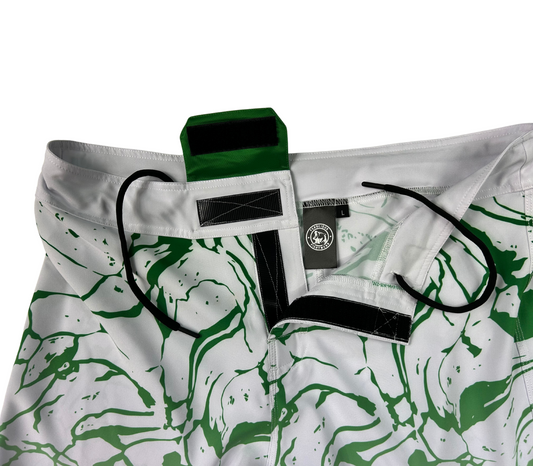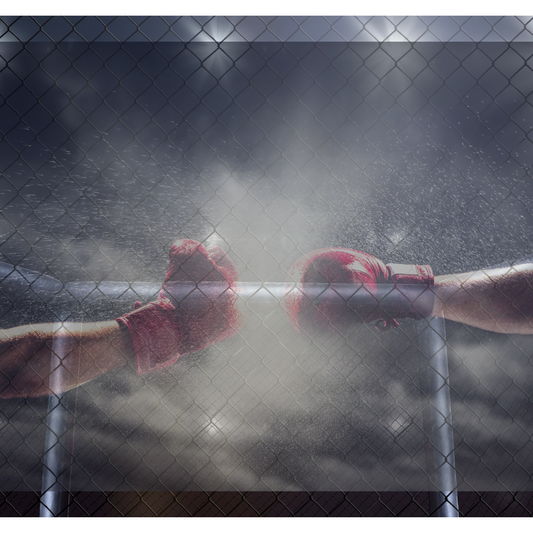Weight Cuts In MMA - Should The Practice Be Abolished And Is It Dangerous?
Weight misses in MMA is a subject that is currently in the headlines this week given that the fight between Manel Kape and Matheus Nicolau has recently been called off after Kape missed weight by 3.5lbs. Kape and Nicolau were due to compete at 125lbs in the UFC’s flyweight division. The limit for fighter’s competing in this division is 126lbs, however Kape weighed in at 129.5lbs. It was initially reported that Nicolau had agreed to still fight Kape and he was due to receive 20% of Kape’s purse as compensation however the fight has since been cancelled altogether.
This begs the question, what is the impact of weight cutting in MMA and should this historical practice be abolished?
In this blog post, we'll delve into the reasons behind weight classes, explore the advantages gained by fighters who cut significant amounts of weight, weigh up the risks and benefits of this controversial practice and look at potential solutions to the problem.
Weight Classes
Weight cuts in combat sports have been a longstanding practice with a history that dates back several decades. The exact origin of weight cutting is challenging to pinpoint, but it became more prevalent as the sport of boxing evolved in the late 19th and early 20th centuries. The introduction of weight classes in the early 20th century, particularly in the 1920s and 1930s, marked a significant development. With the establishment of weight divisions, fighters began to explore ways to gain a competitive advantage by manipulating their weight to fit into lower weight classes.
Recognizing the need for structure and safety, the UFC implemented weight classes starting with UFC 12, which took place on February 7, 1997. The introduction of weight classes brought more legitimacy to the sport and allowed fighters to compete against opponents with similar physical attributes. The original weight classes included lightweight (under 200 lbs), heavyweight (over 200 lbs), and a middleweight (under 200 lbs) class. Today the UFC has 8 weightclasses for it’s male competitors and 3 for it’s female divisions. These classes range from 125lbs to 265lbs for the men and 115lbs to 135lbs for the women.
The Weight Cutting Predicament
While weight classes initially served their purpose, the contemporary MMA landscape is marked by a new challenge – extreme weight cutting. Fighters, like Alex Pereira, who competed at 185lbs before moving up a weight class to 205lbs, demonstrates how the practice of cutting substantial weight can confer a significant advantage. When recently appearing on the Ariel Helwani show Pereira was asked how much he weighed when he stepped into the cage when fighting at middleweight he responded by saying ““When I fought at 185 lbs, I entered the cage at about 210 lbs. After hydration, food, and everything, it would be around 216 lbs. Regardless of the weight class, during training camp, it usually hovers between 210-215 lbs.” The average UFC fighter is believed to cut approximately somewhere in the region of 15-20lbs, Alex pereira was able to cut as much as 31lbs on some occasions and in doing so gained a significant advantage. Other fighters who endured significant weight cuts include Conor McGregor who once fought at 145lbs and has since fought as high as 170lbs.
Which fighter has the greater disadvantage?
When a fighter misses weight in combat sports, both the fighter who failed to make weight and their opponent face disadvantages, but the specific impact can vary depending on the circumstances. Here are considerations for both sides:
Fighter Who Missed Weight:
Penalties: The fighter who fails to make weight typically faces financial penalties, such as forfeiting a percentage of their purse, which is often awarded to their opponent.
Physiological Disadvantages: A difficult weight cut can leave the fighter who missed weight fatigued, dehydrated, and potentially weakened. This can affect their endurance, strength, and overall performance in the actual fight.
Mental Impact: Failing to make weight may also have psychological effects on the fighter, leading to increased stress and distraction.
Opponent Who Made Weight:
Size and Strength Disadvantages: The opponent who made weight is now likely facing an undersized opponent. The advantage of competing in a particular weight class is that fighters are generally evenly matched in terms of size and strength. An undersized opponent may struggle against a naturally larger and stronger opponent.
Compensation: The opponent who made weight may receive financial compensation for the weight miss, but the primary disadvantage lies in the potential physical discrepancies in the actual fight and this could result in the fighter losing the fight and ultimately standing a lower chance of winning any fight bonuses such as win bonus, performance of the fight or fight of the night which in the UFC each are worth $50,000.
The Solution:
This brings us to the point of this article…
How do we keep the sport fair by having fighters compete at the same weight while simultaneously not causing fighters to risk their own health by cutting weight to gain an advantage?
ONE Championship (ONE FC), another prominent MMA organization based primarily in Asia, has implemented a unique approach to address the weight-cutting issue. At the time of writing this is perhaps the best current solution to cutting weight.
ONE Championship's approach to weight cutting involves a combination of hydration testing and a more gradual weight management system. Here are 2 key aspects of their procedure:
Hydration Testing: ONE Championship uses a comprehensive system of hydration testing to ensure fighters are competing at a safe weight. This involves monitoring the fighters' weight and hydration levels throughout their training camps, rather than just during the weigh-ins. Fighters are required to undergo multiple weight checks and hydration tests in the weeks leading up to the event.
Walking Weight: Instead of focusing solely on the weight at the time of the weigh-in, ONE Championship considers the fighters' "walking weight" – the weight they naturally carry in their day-to-day lives. This helps prevent extreme weight cutting practices where fighters may dehydrate themselves significantly to make weight.
The dangers of cutting weight:
Extreme weight cutting poses significant risks to the well-being of MMA fighters. Dehydration, electrolyte imbalances, and compromised cognitive function are just a few of the dangers associated with cutting excessive weight. The potential for long-term health issues, coupled with the immediate impact on performance, calls for a closer examination of whether weight cutting has spiraled out of control and is putting athletes in harm's way.
Methods used in cutting weight:
Weight cutting in combat sports involves various practices, and some fighters employ strategies to gain an advantage by manipulating their weight before a competition. It's important to note that while these practices are common, they can pose significant health risks, and sports organizations are increasingly implementing measures to address extreme weight cutting including banning some of them.
Dehydration Techniques: Fighters often use methods to shed water weight rapidly in the days leading up to weigh-ins. This can include intense cardiovascular exercise, saunas, and hot baths to induce sweating. Dehydration can lead to a temporary reduction in body weight but poses health risks, such as electrolyte imbalances, reduced kidney function and decreased performance.
Extreme Dieting: Fighters may adopt drastic dietary measures, including severe calorie restriction and the use of diuretics or laxatives, to reduce their overall body weight. This approach is not only physically demanding but can also lead to nutritional deficiencies and decreased energy levels.
Sauna Sessions: Spending time in saunas or hot rooms is a common practice for weight cutting. The heat promotes sweating, aiding in the rapid loss of water weight. However, excessive sauna use can contribute to dehydration and increase the risk of heat-related issues.
Weight-Cutting Supplements: Some fighters use supplements that are claimed to aid in weight loss or water manipulation. These can include diuretics or other substances, but the safety and efficacy of such supplements are often questionable.
Performance-Enhancing Drugs (PEDs): While PEDs are not directly related to weight cutting, some fighters may resort to using them to enhance their physical performance and recovery during training. PEDs can include anabolic steroids, growth hormone, and other substances. The use of PEDs is against the rules of most sports organizations and can lead to serious consequences, including suspension or expulsion.
Intravenous (IV) Treatments: Intravenous rehydration, particularly through the use of saline solutions, has been employed by fighters after weigh-ins to quickly replenish lost fluids. However, many sports organizations, including the UFC, have implemented regulations to restrict or ban the use of IV treatments due to health concerns.
It's crucial to recognize that these practices carry health risks, both short-term and long-term. Dehydration, nutritional imbalances, and the use of PEDs can have severe consequences for the athletes' well-being. As a result, many sports organizations are actively working to address these issues through stricter regulations, increased monitoring, and education on healthy weight management.
To conclude, In the ever-evolving world of MMA, the role of weight cutting is a subject of ongoing debate. While weight classes were introduced to ensure fairness and safety, the prevalence of extreme weight cutting has blurred the lines between competitive advantage and potential danger. As the sport continues to grapple with this dilemma, a careful and nuanced approach is needed to strike a balance between maintaining the integrity of weight classes and safeguarding the well-being of its athletes.




